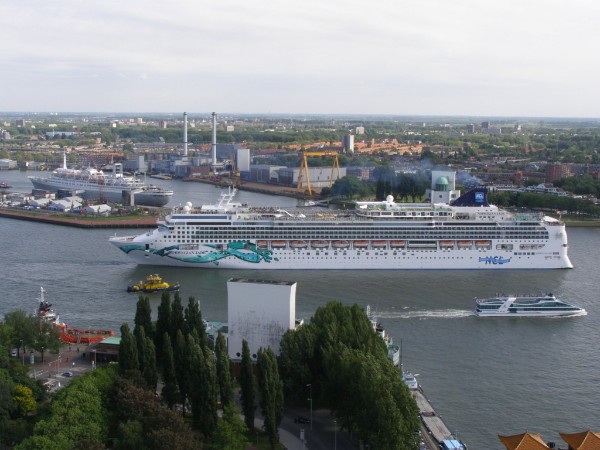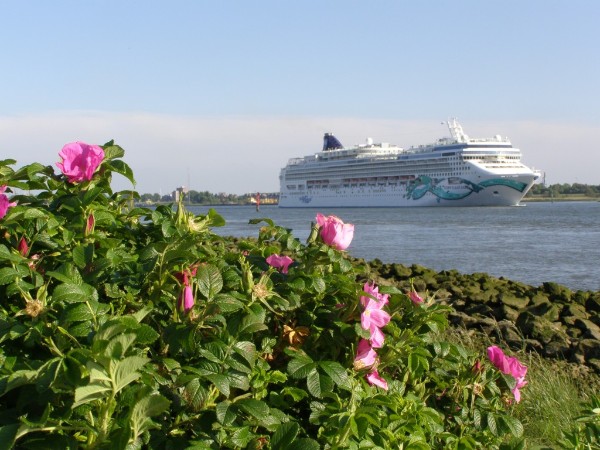Norwegian Jade
Background
In a surprise move, the Malaysian company Genting in the form of Norwegian Cruise Line, announced that they would start up an American flagged cruiseline for cruising around Hawaii, taking over the failed Project America from the revived United States Lines, a venture of American Classic Voyages. In this venture, a two-ship class was to be built. Due to bad financials, the scheme was dying soon during building of the first ship and work was suspended. NCL took over the contracts and had the first ship build, but they decided to lenghten her hull and name her Pride Of America. Originally intended for United States Lines, the ship was to be named Pride Of The America's, so they kinda sticked to the plan. The ship was registered at Honolulu, Hawaii. NCL also bought the since 1963 laid-up United States and the Independence and stated that both ships would be rebuilt too for American cruiseservice. It seemed both ships did have a future now, because under Genting ownership a large company with finances available would be owning them, using also a vivid plan. To earn a little extra before rebuilding would start, the company, dubbed NCL America, would have the second vessel that was planned for the Project America finished as a slightly larger sister to the 'Jewel'-class. Several parts that were already built for the second Project America ship would be used as buildingblocks for the newly designed ship.
The 'Jewel'-class, to which the ship was redesigned, was basicly a slightly changed design from the original 'Libra'-class of ships intended for Star Cruises. These two ships were transferred to NCL after Genting bought the financially questionale Norwegian Cruise Line in 2000 and had entered service as Norwegian Star in 2001 and Norwegian Dawn in 2002. These ships are now known as the 'Star'-class. The 'Jewel'-class of ships started with the Norwegian Jewel in 2005, followed by Pride Of Hawaii in 2006, Norwegian Pearl in 2006 and Norwegian Gem in 2007.With 93.000-tons, these were the largest ships then ordered for NCL.

Above, Norwegian Jade is seen at one of her few visits to the port of Rotterdam in early 2008, passing the 1958-built former Holland America flagship that is now moored permanently in its namesake port.
Construction and general statistics
The ship that was to become Pride Of Hawaii was built at the wharf of Jos L. Meyer at Papenburg, northern Germany and she measures some 93.558 tons. She has a lenght of 294 meters, is 32 meters wide and her draft is 8 meters. The ship can sail with up to 2224 passengers and 1100 crew on her 15 decks. Of those decks, 12 are available for the passengers. Costing over half a billion US Dollars to built, she was the most expensive passengership that had ever sailed under the flag of the USA, as she was registered at the port of Honolulu, Hawaii. The first block of the ship was laid down at the 5th of february of 2005 at the German wharf. At the 19th of february of 2006, the ship left her building dock and after satisfactory trials, she sailed for the port of Los Angeles to be named.
Design
Originally, the ship was going to be a vitual sister to Pride Of America and so her final appearance would be drasticly different then originally intended. But the parts that had already been build were easily placed within the new design without spotting any difference at all.
To keep the Hawaiian theme, the ship was designed in very bright colours and with an overflow of flowery designelements. Also her hullart was a string of Hawaiian flowers, but then significantly larger... She was clearly marketed for families and young adults and uses the same Freestyle concept as larger sister Norwegian Cruise Line. For diner, ten different diningvenues were available, ranging from traditional dining to Asian, Italian, Tapas or American stakehouse. This all in Freestyle, so there are no fixed times or tables, although for several of the speciality restaurants a small fee has to be paid for reservations. The main dining room was named the Alizar Diningroom, decorated with artworks designed by Mark Rothko and decorative walls that change colours during diner. Next to all places to dine, there are 12 bars and lounges to relax through the evening nipping on a nice drink. To let the passengers know how much waitingtime there is for the restaurants, monitors are placed aboard that show availability of tables using a bar that goes from green (available) to red (full). Also the availability of tables for two is shown.
The Stardust Theater is done in Venetian art-nouveau style and has 1037 seats and spans three decks. In the first seasons, the Jean Ann Ryan Company provided the colourfull shows in true Las Vegas-style. Also, the theater is used for cabaret entertainment.
Atop the stern, the large Spa and healthcenter are placed, featuring an indoor lap pool, hydrotherapy pool, aromatic room, 15 massage/therapy rooms, couples massage rooms, a beauty salon and a mud treatment room. The space was operated by the Hawaian-based Mandara Spa.
As an extra, the ship was designed with the largest spaces available for conferences at any cruiseship, spanning some 9300 square meters. Included on this special deck is a circular auditorium with a state-of-the-art audiovisual system that operated several screens.
To find one's way around the ship, the company makes use of pictured dolphins in the carpeting. The dolphins always swim to the bow, so if you are heading forward just follow the dolphins. This is a system also used aboard the ships of Norwegian Cruise Line, where you can always find your way forward by following the white fish in the companies logo.
Below, the ship sails past the village of Maassluis in 2008 at the New Waterway, connecting Rotterdam with the sea.

Carreer
On may 22nd of 2006, the ship was named Pride Of Hawaii at the San Pedro pier in Los Angeles by Hawaiian senator Daniel Inouye, who is a Medal of Honour recipient who was born in 1924. The ship then settled in for her seven day cruises around the Hawaiian islands as a thirth ship for the NCL America brand, following Pride Of America and Pride Of Aloha. As it was also planned for the old United States and Independence to be rebuilt for this service, it is a little odd that nobody padded them on the shoulder asking if all these ships would be needed in a market like Hawaii. But from the rebuildingsceme for the classic liners finally came nothing anyway and Independence was even sold for scrap soon. United States was sold, but remained. A later study by Crystal Cruises to retern her to service also came to nothing so we can now say that the old American greyhound will never set sail. So the three new ships it was, but also this seemed way over capacity for the market.
In april of 2007, NCL announced that the thirth ship in the fleet had causes a drop in prices in the Hawaiian market, meaning the capacity was overrated. She was taken out of the NCL America brand and placed in the main Norwegian Cruise Line fleet from february of 2008 onwards. The plan was to replace her in Hawaiian service when the situation improved, but it never has. But it was the reason why the ship, that was now sent to Europe, kept her Hawaiian decor, including the flowery patterns, decknames, Matson Line menu inspired artworks and also the statue of King Kamehameha in the main diningroom. At february the 8th of 2008, the ship left Honolulu for the last time.
She recieved a small update, though, now including an onboard casino which was not possible under the American flag and also her hull-art was changed. And of course her name, as the ship was now renamed Norwegian Jade, in line with the other 'Jewel'-class ships.
After her first European season, Norwegian Jade mostly sailed northern European and Mediterranean cruising and she now has become a steady member to Norwegian Cruise Line's own fleet. Her peacefull sailings were somewhat interrupted on the 9th of march 2014, when the ship docked at Tunis. The Tunesian authoroties refused to let several Israeli passengers disembark because of their origins and in reaction, Norwegian Cruise Line immidiately cancelled all remaining stops in Tunis and apologized on their behalf to the passengers involved. Of course, the reaction of NCL is the only right one, but we must not forget that cruising in regions where historic and emotional tensions are sensitive, like in Arabia and northern Africa, things like this do occur. Cruising always seem to bring people closer to eachother, but untill we all can just accept eachother also, we must not forget that those regions have their problems and we ourselves have also to choose our cruises carefully and make us familiar with local situations.
The ship was chartered for the 2014 winter Olympic Games at Sochi and used as a hotelvessel in the port of Sochi throughout the event. Afterwards, she again settled in for her European sceme of sailings.
2017 upgrade
In 2017, it seemed clear that the ship was not going to be replaced in the Hawaiian fleet. She now lost her Hawaiian theme and recieved a toned down interiour 3-week upgrade costing around 40 million dollars. The ship now is mostly done in soft colours, 'cappucino', and cream, something that is more appealing to European customers. Also new bars and lounges were added, just like two additional restaurants. Of course also the cabins were upgraded and refurbished. To be placed more upmarket, the menus in the restaurants were accordingly improved, using guidelines from Oceania Cruises, another line in NCL's portfolio and known as a 'foodie' cruiseline.
After the upgrade, the ship returned to European cruiseservice from mainly Hamburg and Southampton that were used as her homeport cities. In the European winter, the ship sails out of Florida for a series of Caribbean cruises from Miami.

